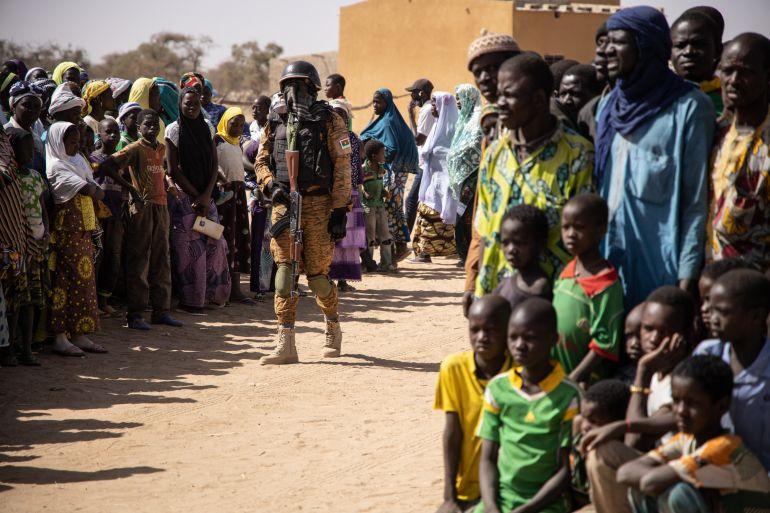Source: ALJAZEERA
ALJAZEERA MEDIA NETWORK

A Norwegian Refugee Council report highlights the world's most neglected displacement crises, with nine out of ten countries listed being African nations.
Annually, the Norwegian Refugee Council (NRC) releases a report identifying the world's most overlooked displacement crises. These are the countries where millions are displaced, suffering from violence, hunger, illness, and losing their possessions.
Burkina Faso has been identified as the worst for the second straight year, followed by Cameroon, the Democratic Republic of the Congo (DRC), Mali, Niger, Honduras, South Sudan, the Central African Republic, Chad, and Sudan.
“The sheer neglect of displaced people has become normalized,” stated Jan Egeland, Secretary-General of NRC, about the report.
“Local political and military leaders show disregard for the suffering they cause, and neither horrifying stories nor staggering statistics provoke a reaction from the global community.”
Here’s a detailed look at the crises in these countries, rated by neglect.
Internally displaced individuals are those forced to flee their homes with minimal belongings while staying within their own country.
These individuals flee due to life-threatening circumstances, yet they typically find almost no aid when they cease to run.
This results in inadequate shelters, tents, food, water, medications, sanitary facilities for women and girls, toilets, showers, clothing, security measures, comfort items, or means of communication with the outside.
Burkina Faso has become the center of violence by armed groups in Africa’s central Sahel region since the late 2010s, resulting in thousands of deaths and the displacement of hundreds of thousands.
The government has struggled to address security challenges, culminating in a coup where the army assumed control in September 2022.
The violence resulted in over 8,400 deaths last year, doubling the previous year's toll, according to the NRC.
By the end of 2023, around two million civilians were confined in 36 blockaded towns across the nation.
In Cameroon, violence has stemmed from the Francophone government's oppression of Anglophone protests against marginalization.
A separatist conflict began in 2016 when the government suppressed protests in English-speaking regions.
Since then, more than 6,000 people have perished in those areas.
Escalating violence displaced over one million people internally by the end of 2023, according to NRC.
Alongside the internal displacement, Cameroon also hosted refugees from neighboring nations, straining the country's resources.
The DRC has long endured armed violence, with both the government and foreign entities arming the combatants.
By the end of last year, approximately 6.9 million people were displaced, mainly in the eastern provinces.
An uptick in hostilities in March 2022 drove more than 1.6 million from their homes in North Kivu, in the east.
The 2023 withdrawal of a 13,000-strong peacekeeping force led to increased clashes between the state military and non-state armed groups in northern Mali.
Mali struggled to combat armed groups alone, causing thousands to flee their homes for safety.
As of December 2023, more than 340,000 people were internally displaced, reports the NRC.
A coup in July 2023 resulted in Niger losing support from Western political and financial partners and severing regional ties.
Increasing insecurity and non-state armed groups in regions like Diffa, Maradi, Tahoua, and Tillabery forced more than 335,000 people from their homes.
Niger also sheltered 290,000 refugees and over 35,000 asylum seekers from neighboring countries, as stated by the NRC.
In 2023, Honduras faced widespread violence, organized crime, climate shocks, deep poverty, and hunger.
Nearly 250,000 displaced people needed support with food, protection from violence, and other essentials.
South Sudan has been embroiled in various armed conflicts since 2013 when political tensions between the president and vice president led to violence.
Economic instability, severe flooding, drought, and a 2023 conflict in neighboring Sudan worsened the situation, causing recurrent displacement.
Over four million people have been displaced, including 2.2 million who fled the country.
Since 2013, the CAR has been plagued by violence after predominantly Seleka rebels ousted then-President Francois Bozize, prompting reprisals from mainly Christian militias.
Per the NRC, despite a slight reduction in violence, northeastern CAR has been impacted by the Sudan conflict and border area insecurity.
One out of five Central Africans remain displaced within the country or as refugees due to ongoing violence.
Following the outbreak of war in Sudan, over 600,000 people fled ethnically-driven attacks in West Darfur, seeking refuge in eastern Chad.
Before this crisis, Chad was already hosting more than half a million refugees from neighboring countries like Cameroon, the CAR, Nigeria, and Sudan, NRC reports. Additionally, about 200,000 Chadians are displaced within their own country.
Thousands have died, and millions have been displaced due to the conflict between the army and the paramilitary Rapid Defence Forces that erupted in April 2023.
The NRC notes that 1.4 million people fled across the border, and over eight million were internally displaced, marking Sudan as the site of the largest internal displacement crisis globally.
Your email address will not be published. Required fields are marked *